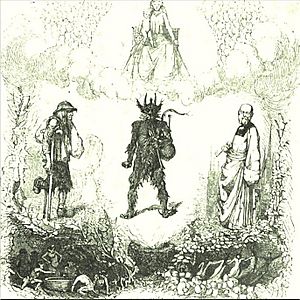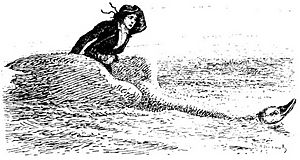Le Foyer breton facts for kids

Cover of the first edition
|
|
| Author | Émile Souvestre |
|---|---|
| Illustrator | Tony Johannot, O. Penguilly, A. Leleux, C. Fortin and Saint-Germain |
| Cover artist | Octave Penguilly |
| Country | France |
| Language | French |
| Genre | Short story collection |
| Set in | Brittany |
| Publisher | W. Coquebert |
|
Publication date
|
1844 |
| Pages | 238 (first edition) |
| 398.21 | |
Le Foyer breton (which means "The Breton Hearth" or "The Breton Home" in English) is a collection of exciting stories from Brittany, a region in France. Émile Souvestre wrote these stories in French, and they were first published in 1844.
This book gathers many traditional folktales from different places in Brittany. It became very popular right away. It even inspired other writers, like Ernest du Laurens de la Barre. The book has been printed many times since it first came out.
Contents
Are the Stories Real?
When Le Foyer breton was reprinted in 1947, people started to wonder if the stories were truly authentic. Some thought Souvestre had changed them a lot. Others even believed he might have made them up entirely.
One expert, Gourvil, said that Souvestre "dressed up" old stories. He added details to make them sound more like Breton tales. Another expert, Paul Delarue, said that the stories in Le Foyer breton were "fabricated." This means they were changed or created by the author.
What Stories Are Inside?
The book contains many interesting tales. Here are some of them:
- La Ferme des nids (The Farm of Nests)
- Comorre
- Les Trois Rencontres (The Three Meetings)
- Jean Rouge-gorge (Robin Redbreast John)
- La Forge isolée (The Isolated Forge)
- Les Lavandières de nuit (The Night Washerwomen)
- La Groac'h de l'Île du Lok (The Groac'h of Lok Island)
- Invention des Ballins (Invention of the Ballins)
- Teuz-ar-Pouliet
- L'Île de Saint-Nicolas (Saint Nicholas Island)
- Keris
- La Souris de terre et le corbeau gris (The Field Mouse and the Grey Crow)
- La Hutte du sabotier (The Clog Maker's Hut)
- Le Diable devenu recteur (The Devil Who Became a Rector)
- Les Korils de Plaudren (The Korils of Plaudren)
- Peronnik l'idiot (Peronnik the Idiot)
- Les Pierres de Plouhinec (The Stones of Plouhinec)
The Groac'h of Lok Island
One of the most famous stories in the collection is La Groac'h de l'Île du Lok. A groac'h is a type of fairy sorceress from Breton legends.
The story is about two cousins, Houarn Pogamm and Bellah Postik. They grew up together and fell in love. But they were poor, so Houarn decided to leave and find his fortune. Bellah gave him a small bell and a knife. She kept a magic wand for herself.
Houarn traveled to Pont-Aven. There, he heard about the groac'h of Lok Island. She was a fairy who lived in a lake on the Glénan Islands. People said she was richer than all the kings on Earth. Houarn went to Lok Island and found an enchanted boat shaped like a swan. The boat took him underwater to the groac'h's home.
The beautiful groac'h asked Houarn what he wanted. He said he was looking for enough money to buy a cow and a pig. The fairy offered him magic wine and asked him to marry her. He agreed. But then he saw the groac'h catch and fry fish that moaned in the pan. This made him scared, and he regretted his choice.
The groac'h gave him the fried fish and left to get wine. Houarn quickly pulled out his knife. Its blade could break spells. All the fish stood up and turned into little men! They were victims of the groac'h. She had tricked them into marrying her, then turned them into fish to serve as dinner for other visitors.
Houarn tried to escape, but the groac'h returned. She threw a steel net from her belt at him. It turned him into a frog. The bell around his neck rang, and Bellah heard it all the way in Lannilis. She grabbed her magic wand, which turned into a fast pony. Then it became a bird to fly across the sea.
On top of a rock, Bellah found a small black korandon. This was the groac'h's husband. He told Bellah the fairy's secret weakness. The korandon gave Bellah men's clothes so she could disguise herself. She went to the groac'h, who was happy to see such a handsome "boy." Bellah asked to catch fish with the steel net. The groac'h agreed.
Bellah threw the net on the fairy, saying, "Become in body what you are in heart!" The groac'h changed into a horrible creature, like a queen of mushrooms. Bellah threw her into a well. The men who had been turned into fish were saved, along with the korandon. Bellah and Houarn took the fairy's treasures, got married, and lived happily ever after.
This tale is important because it tells us a lot about the groac'h character. Souvestre said he chose Lok Island because many storytellers placed the groac'h there. La Groac'h de l'île du Lok was even more popular in Germany than in Brittany!
English Versions of the Stories
The entire Le Foyer breton book has not been translated into English. However, many of its stories have been translated or adapted. Some examples include:
- Patrick Kennedy included a version of Les Korils de Plaudren in his book Legendary Fictions of the Irish Celts (1866).
- Andrew Lang retold five of the stories in his book The Lilac Fairy Book (1910).
- George Moore wrote Peronnik the Fool (1921).
- G. H. Doble created a play called The Rector of Concoret: or, The Devil Turned Rector (1925). This was based on Le Diable devenu recteur.
- Roseanna Hoover translated Peronnique: A Celtic Folk Tale from Brittany (1970).
- Marjorie Dixon translated 10 of the stories in Breton Fairy Tales (1971).
- Re Soupault and Ruth E. K. Meuss included versions of Peronnik l'idiot, La Groac'h de l'Île du Lok, Comorre, and Keris in Breton Folktales (1971).
- An anonymous author published Peronnik: A Fairy Tale of the Grail Quest (1984).


